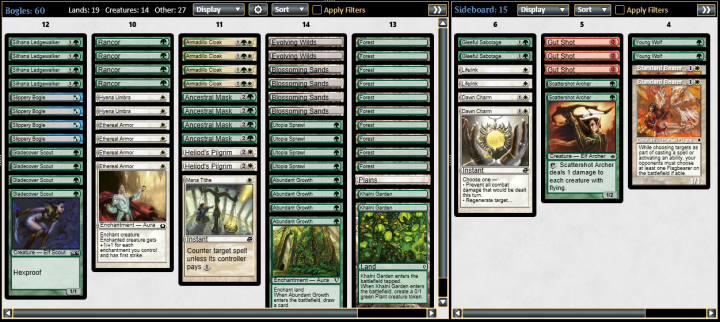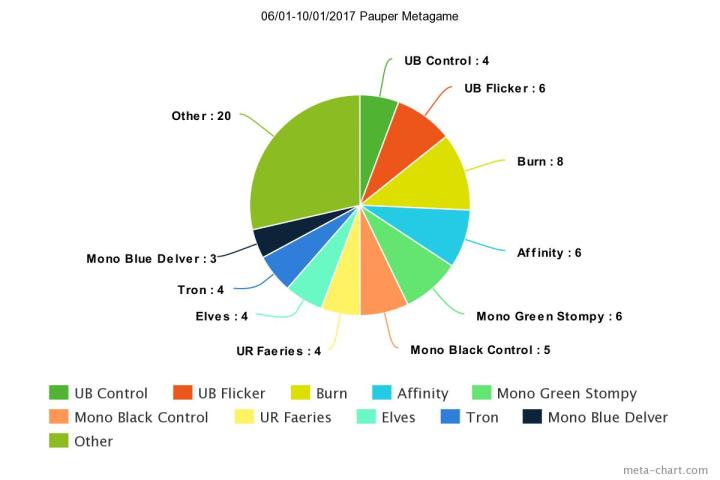As I said last week, I have moved on from Elves — I’m currently on Bogles. So far, I have only played the list I copied from sakkra, but I have lots of thoughts and ideas I want to share here.
For the first time, I am also including a small breakdown of the decks I have faced this week. If this is something you are interested in, I will continue to do this. Once I have more extensive data, I might also devote a full article outlining metagame evolutions.
Without further ado, let’s get into the lessons I have learned in my first week playing Bogles.
(deckstats.net link, includes thoughts on some card choices and future ideas)
#105 — Efficiently casting spells.
The mana system on Magic Online is really weird (you will know how annoying this is if you follow @itsJulian23 on twitter). When you’re casting spells that cost hybrid mana, you will have to manually click the mana you have floating, so if you’re casting Slippery Bogle, you’re wasting clicks if you tap your land first.
Interestingly, if you have a land enchanted with Utopia Sprawl, casting your spell and then tapping the land will also make you click your mana, even if you’re casting a spell that costs G and your land taps for GG. Go figure.
To sum up, if you want to efficiently cast your spells, cast spells with hybrid mana costs before tapping your lands, but tap lands that produce more than one mana before casting your spells. Yes, reading this probably cost your more time than it will save you. Sorry.
#106 — You don’t have to attack.
Combat math is really tricky sometimes, especially when Lifelink is involved. When you have an 8/8 Lifelink Trample creature, it can seem like the obvious move to attack in order to gain life, but sometimes, once you factor in your opponent’s reach, not attacking can be the safer option.
By keeping your creature back as a blocker, you might disincentivise your opponent from attacking and once you draw more enchantments you will have an attack that’s actually safe. Just keep in mind that Armadillo Cloak’s lifegain is a trigger, so you can still potentially lose to burn spells when opting to block (this is mainly relevant against Fling).
#107 — Armadillo Cloak randomly acts as removal.
Because Armadillo Cloak doesn’t grant the creature it’s on lifegain but has its own trigger, you will always gain life, regardless of who controls the creature it’s enchanting. This means that you can put it on an opposing creature to shut off its damage output. This is not something that comes up often, but it is worth knowing about.
#108 — Ancestral Mask does not count itself, but it counts all other enchantments.
Just something to pay attention to. Ethereal Armor counts all auras you control, whereas Mask counts all other enchantments on the battlefield, even your opponent’s. I’ve had people play random enchantments against me and then die to the boost they had inadvertently given my creature.
#109 — White decks have Flagbearers…
…and Bogles has a very hard time beating those. Basically, whenever you play against a white deck, you need plan in case your opponent casts one of these. Originally, my primary answer to them has been Gut Shot, but I now think bringing your own Standard Bearers is a better solution. When both players have a Standard Bearer, you can chose either one as a target for your spells, not just your opponent’s. There’s also the potential to play a copy of Lignify, which can be searched with Heliod’s Pilgrim.
#110 — Leave no Trace is a thing.
At first I thought only green decks had good mass removal for enchantments, but it turns out this card also exists. You can’t always play around it, but you shouldn’t blindly play into it either.
#111 — Celestial Flare & Tangle.
Coming back to combat not being trivial, these two cards are also worth paying attention to. Celestial Flare is not something many decks have because White also gets Standard Bearer, Leave no Trace and Circles of Protection, but I have seen it. It’s very hard to have a read on Celestial Flare because the mana they’re holding up also represents Leave no Trace, but sometimes you can beat Flare more or less for free, which you should do if possible. Although you shouldn’t bother if attacking with two creatures is too bad against Leave no Trace, because it’s usually much more likely they have that card in their deck.
#112 — Bogles’ manabase can be improved.
Am I ever happy with a deck’s manabase? I guess there are some I don’t hate…
In all seriousness though, this one’s not too bad. I like that Bogles gets to play decent fixing in Utopia Sprawl and Abundant Growth. It’s also not that heavy on White mana symbols; you rarely need more than one White. The fifteen sources my list currently has are definitely enough, I’m just not the biggest fan of the lands.
In general, I think there are too many tapped lands in Pauper, more than there have to be. Crumbling Vestige has been around for a while and now there’s also Ash Barrens. While the latter has been catching on, I still think it’s underplayed and I’m most likely going to try a split between the two for my next list.
#113 — Why Gleeful Sabotage?
This is not a rethoric question. Almost all green decks in the format play this card, but I really don’t see why. I didn’t like it Elves because it was too clunky and this deck has fewer creatures and less mana. I almost never get to destroy two cards and when I do, it’s usually one good card and another that’s mediocre at best.
It doesn’t help that the good cards in Affinity are not the artifacts either.
In the context of this deck, don’t even think you need that much help against Affinity. The matchup is decent and I do not play it all that much anymore anyway. I think Dawn Charm and Lifegain are much better cards to have against them.
#114 — On Gut Shot.
I think this card is in a similar spot to Gleeful Sabotage. It’s a decent effect that gets played somewhat often, but in reality, its uses are limited.
Gut Shot has some really great moments against Faeries, but most of the time, you’d rather Scattershot Archer against them.
It’s a good card against Elves because it kills almost anything. Except that it’s not good because doesn’t kill everything. Elves is really good at beating one or two removal spells, it’s only sweepers that give the deck issues. Elves doesn’t usually mind losing its first mana creature, not does it fall apart if it loses a Wellwisher. The deck is quite redundant and very good at going over the top of other creature decks. If you really want to stunt Elves’ board development, you need sweepers.
The one good thing Gut Shot does is killing Standard Bearers, but as I mentioned before, I actually think bringing your own copies is better. Standard Bearer is also very good against Elves in shutting off Quirion Ranger (which is behind their most explosive draws) and Timberwatch Elf (which they usually need to kill you).
What I played against last week:
Interestingly, the top five decks make up for half the decks I faced. I feel it makes sense to count UB Control and UB Flicker as one deck here; the split might not even be accurate because some of the deck’s I labelled as UB could have been Flicker, just never showing the few cards they don’t share.
It’s also interesting how much Burn and how little Kuldotha Boros I have faced (I only played against Kuldotha Boros twice; at the time of this writing, MTGGoldfish has it at 14.48%, the most represented deck). Playing against Kuldotha a significant portion of the time was one of the main reasons I switched off Elves, now it has all but disappeared. Because of this, I might go back to Elves at some point, although I’m not super happy with Elves vs. Burn either.
I don’t think any of the common matchups are bad for Bogles though, so I’m going to stick with it at least a little longer. I don’t like the deck vs. Elves, but so long as that’s only around 5% of the metagame, it’s not too big a problem.
Thanks for reading.
J

